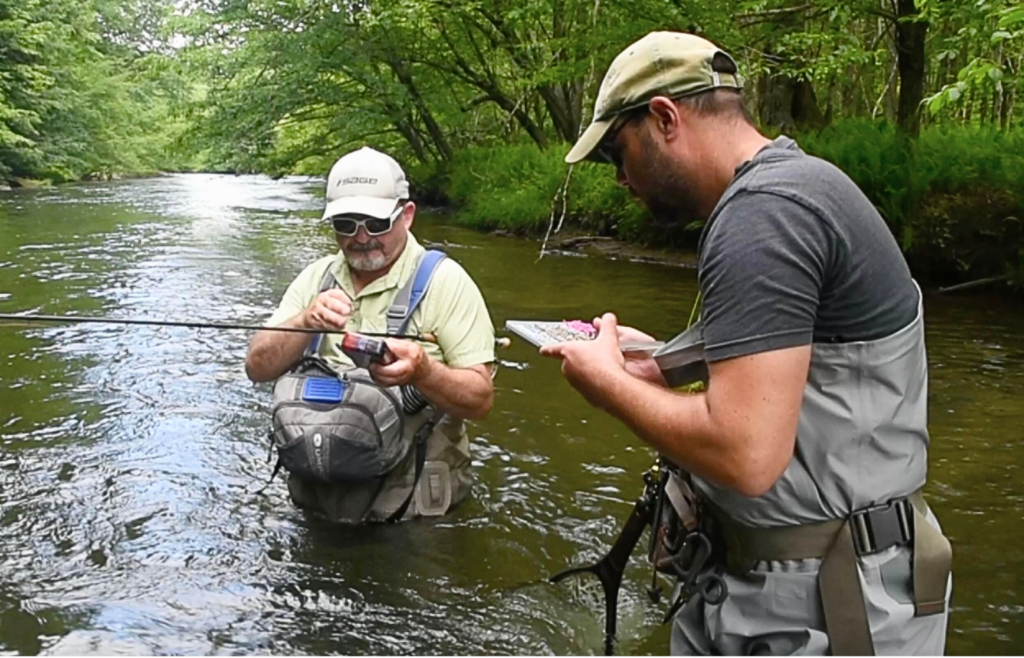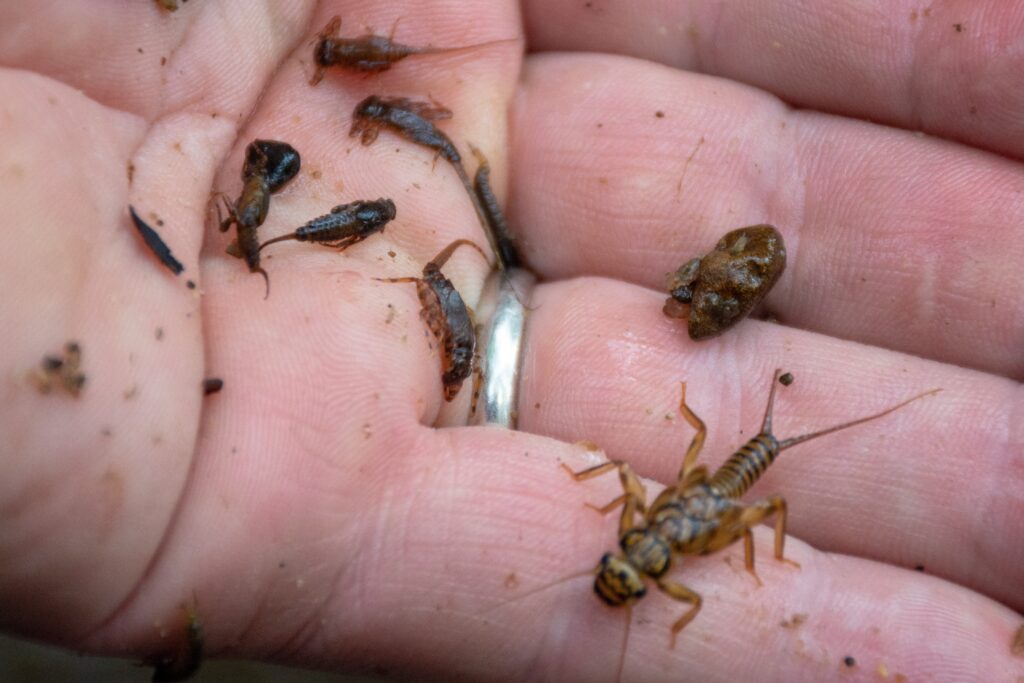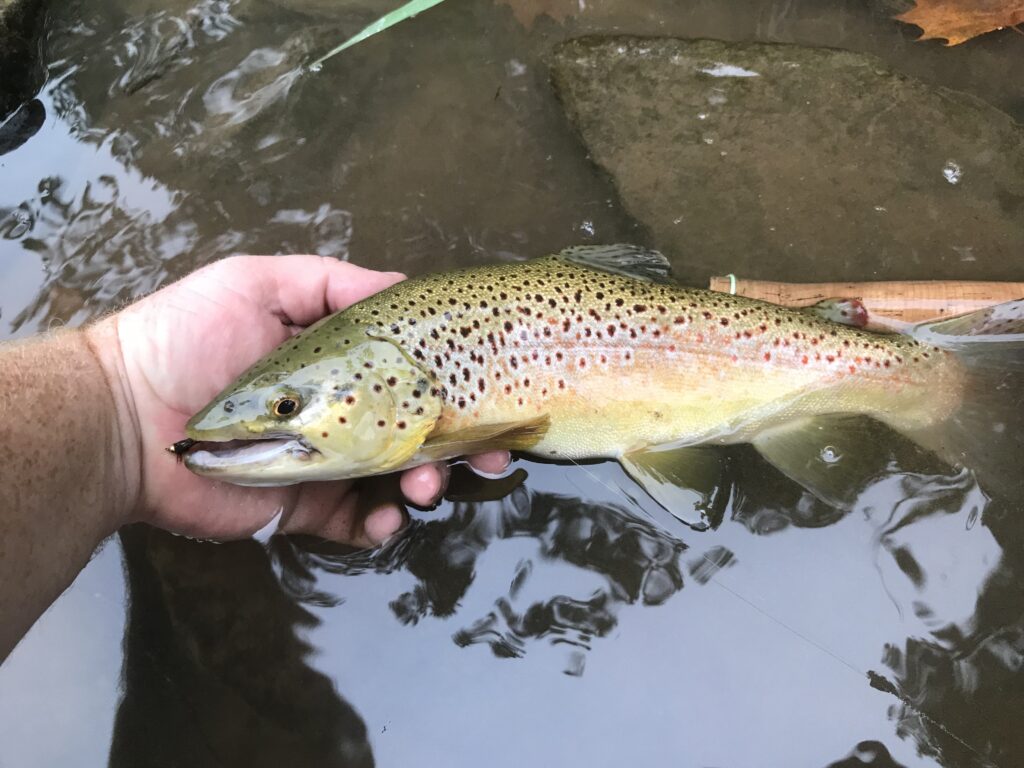When Should You Change Flies?

Recently, I received this message from a reader of this blog:
“When fishing a long pool or long run that you know is holding fish, how many drifts through the pool should you make before you decide it is time to change your fly?” John B., St. Marys, PA.
One of the great mysteries of fly fishing is knowing what fly pattern to use, when to use it, and how to use it. This, of course, implies that success is largely based on choosing and using the right pattern at the right time. Throw in a few variables, such as weather and mood of the trout, and it can sometimes be hard to figure out if we’re not catching fish because we don’t have the right fly, or if the problem is us. Maybe we just stink!
I’ve had these moments of self doubt frequently on trout streams. It’s amazing how a fish with a pea-sized brain can make us feel so inadequate! But it’s a legitimate question. How do we know when the problem is us, and how do we know when it’s the fly?
In his email, John included a very detailed scenario that he recently experienced on the stream, and I’ll respond to that specifically in just a minute down below. First, let’s address fly changes in general and how to know when you should change your fly.
There are four ways to know when you should change your fly.
1. When a change in weight doesn’t produce better results. In my experience, when nymphing, the main reason we don’t catch fish is because our flies simply aren’t getting down into the strike zone where the fish are feeding. This can mean we need a fly with a bigger, heavier bead, or we need to add split shot to get the fly to the bottom. Or, if our nymph is dragging bottom, we need to lighten up. For dry fly fishing, this means scaling up or down a size or two, or trying a fly with a different profile, to better match whatever insect is hatching.
2. When a different presentation doesn’t work. For instance, when dry fly fishing, trout could be refusing the fly because you’re lining them (the line is traveling over them before the fly) or there’s some sort of micro drag that’s nearly invisible to the naked eye. I see this a lot on special regulations waters, where trout receive a lot of pressure and have been caught and released several times. They simply will not eat with conviction unless everything about the drift is perfect. This could also mean we need to try an upstream or downstream approach, depending on the conditions, swinging the fly, stripping it, etc.
3. When you’ve tried patterns that you consider your “confidence flies,” those that catch fish for you on a regular basis, and still no luck. We all have them. For me personally, if I can’t catch a trout on a Rainbow Sexy Walt, then I know it’s time to start rooting through the fly box to figure out what the trout are feeding on and how to best present it.
4. When you’ve fished a pool or run thoroughly enough that you feel like you should’ve caught something. In other words, if you know you’re putting your fly on their nose and making great presentations, but still no catches, then it’s time to try a new pattern.
Sometimes, I can get a sense of what the trout want and how they want it presented after only a handful of drifts. If I approach a pool or run and know that I’ve placed my fly exactly where it needs to be to elicit a strike, and there are still no takers, I’m already processing what fly I need to try next.
A lot of this comes with confidence. When you’re confident in your ability to read the water and make the right presentation, the more often you’ll find yourself changing flies in order to find the right one for the situation, because you know you possess the technical skills to get the flies where they need to be. Now you just have to figure out what fly the trout want.
It should also be added that the number of drifts needed to fish a stream effectively changes based on the size and complexity of the water. Small, straightforward streams that are easy to read and access might only require 5 or 6 casts, or less, whereas a larger body of water with tricky currents and seams might take 15-20 casts, or more.
But ultimately, I know in my gut when I’ve covered the water good enough to warrant trying something new. I wouldn’t be surprised to find that in most cases I make less than 10 drifts in almost any water before deciding to change my fly. But those are 10 of my best drifts through prime lies where I know trout are holding.

Are You Enjoying What You're Reading?
Stay up to date with the Dark Skies Fly Fishing monthly newsletter for free and receive the latest posts in fly fishing news, tricks, tips, and techniques, stream reports, as well as updates on new flies added to the Online Store and exclusive discounts!
Sign Up NowWhen Should You Change Your Dry Fly?
The rest of John’s email featured a scenario that is very common on the trout stream: fish coming up to look at your fly but ultimately refusing to eat it.
“I was fishing First Fork the last week of October and identified some fish rising downstream,” John writes. “I was fishing the X Caddis I got from you the week before in size 18. A few fish rose to look at it but no bites. I sent that through the spot where I did see activity about 10 times with nothing hitting it. I moved downstream a short distance where I saw more trout rising and again no takers. I moved a third time with the same outcome.
“I walked back to my original spot and the fish were still rising. I saw tiny insects flying around, not sure what they were, but I had some size 22’s and 24’s that somewhat looked like the insects and did the same procedure as listed above in the three different spots. Again no fish. As the morning and early afternoon continued, I tied on weighted nymphs, unweighted nymphs, soft hackles, dry droppers with nymphs or wet flies attached, a few ants and the last fly I tied on was an emerger. I caught zero fish that day.”
First of all, sir, rest assured that I have found myself in this EXACT situation numerous times in my life, and I’m willing to bet that everyone reading this has, too. It can be humbling and demoralizing to have rising fish in front of you that just won’t hit!
The hardest trout to catch are those that are keying in on a specific insect in a specific stage of the hatch. When this happens, I’ve often found myself completely out of luck if I didn’t have a fly that matched EXACTLY what they wanted, and I’m pretty sure that’s what John experienced on First Fork that day.
The most frustrating of all is when you have trout coming up to look at your fly but not eating it. This tells me that the fly is very similar to what they’re feeding on, but not a match, for one reason or another. It could be color, size, or even profile. Before changing the fly, though, I always try a different presentation first, usually incorporating some sort of reach cast and frequent mending so that I know for sure it’s the fly causing the refusal and not drag, etc. Once satisfied that it’s the fly and not me, it’s time for a change.
Typically, in these situations, I drop down a size or two, which John did, and try a pattern with a completely different profile, which it sounds like he also did. What I’m guessing happened, though, is that fish were actually feeding on bugs (likely very small midges!) trapped in the surface film. There’s really no way to tell unless we are able to collect some samples to get a good reference to help choose the right fly and the right stage (emerger, dun, spinner, etc.). A small, pocket-sized seine can really come in handy for these situations.
Admittedly, I have a very quick hook for dry flies; I change flies early and often if I’m not getting results. If I have fish rising in front of me and they don’t hit within a handful of drifts, or I’m getting refusals like John mentioned, I change my fly after only a few casts. If they’re refusing it more than once, chances are that they just aren’t going to hit it even after 20 casts — and if they do, it’s usually with an open mouth, and when you set the hook, the fly comes right out and you never even feel the fish on the end of the line.
It’s not uncommon for me to burn through my whole fly box in these situations in an attempt to find something that works. But again, this is assuming that I’m getting a good, drag-free drift, not lining fish, using the correct tippet size for the fly, and not spooking them on the approach.
And sometimes I just have to accept that I didn’t have what they wanted that day. But it helps me be prepared should I encounter that situation again. Next time I’m back on that stream, I’ll usually have a handful of new patterns that more closely represent whatever insect I think will hatch, and I have them in a variety of sizes and styles, such as emerger, crippled emerger, comparadun, spinner, dun, etc.
Redemption is Sweet When You Have the Right Fly
There’s one final part to John’s email, as he writes:
“Now let me add this. The next day, with the same weather conditions, I was on a different area of First Fork and thought about the day before. On that day, as explained above, I used small flies. So I tied on a size 14 caddis dry fly and on my first cast through the pool I caught a nice rainbow. Smiling and then releasing the fish, I cast again and had a hit on my second cast but lost him. I moved a few feet downstream, and on the next sequence of casts, I landed a trout and had another hit. I never changed flies the entire time and in about 2 hours I caught 7 fish and had multiple rises.”
Sometimes the right fly isn’t always the most obvious. Kudos to John, though, for trying something different the following day and not simply repeating the process of the day before.
This is also a great illustration of how we can encounter similar situations on different days, but the trout could be keying on a different insect, or different stage of that insect, each time.
There are multiple reasons why the size 14 caddis dry fly probably worked so well, namely because fall is a great time for fishing with caddis flies. Not only does the October Caddis usually make an appearance, but many streams experience some type of sporadic caddis hatch, so trout see them and eat them on a daily basis both below the surface and on top. In general, caddis are the most common insect found in streams and rivers across the country.
The biggest takeaway from an experience like this should be to reinforce the idea that if I’m presenting the fly correctly and getting it in front of fish, and I’m not getting hits within a handful of casts, then it’s time to start making adjustments. That can mean adjusting weight, size, presentation, or a combination of all of these.
Just because you start out with one fly doesn’t mean you have to stick with it. Don’t be afraid to change as often as necessary to find the right fly and the right presentation to help you be successful that particular day.
Have a fly fishing question you’d like answered? Drop us a line at info@darkskskiesflyfishing.com! If we use your question in a blog post or in the newsletter, we’ll send you a FREE fly box with a dozen of our favorite nymphs and dry flies!



Great question, John B! And, Ralph’s response is very comprehensive and informative filled with invaluable and practical information. This is a very crucial article that answers such a common question in the realm of fly fishing.
This being said, my approach to selecting and changing flies is different than Ralph’s some of the time. My approach to fly selection is that I mostly don’t! It is not uncommon for me to complete a session on the water and realize I only fished two patterns all day! Trying four or five patterns would be an anomaly for me.
As a European nymph fisherman, I focus far more on changing weight and drift over fly pattern selection. At times, I feel that this does limit me. For example, I remember a session Ralph and I had on Yellow Creek, Bedford County together. We found a pod of rising fish on a glassy slick. I gave up on those fish within moments and moved into the pocket water down and upstream. Ralph threw everything but the kitchen sink at those challenging risers for the better part of two hours. And he hooked several of them, too!
If I am nymphing my favorite water types, riffles, runs and pockets, I stick with one of my confidence flies and make two adjustments. This occurs when I am not hooking up within a dozen or so drifts. Typically, these two adjustments produce fish in the net before needing to change fly patterns.
1. Angle of Approach: When not getting any takes on a drift, change the approach angle. I like to take one to three steps forward, backward, right or left. Sometimes, this position adjustment is all that it takes to better present a fly in a given seam or pocket and elicit eats. I also adjust my casting angle. Switching to a nearly upstream cast and drift after fishing the forty-five degree angle might be the winning presentation. So, as Ralph explained, think presentation first before reaching for that fly box.
2. Weight: One of the most crucial skills European nymphing is selecting the proper weight to present the flies in the feeding zone in any given section of water. If I am not reaching the feeding zone of trout or continually ticking and snagging stream bottom structure, I add or remove weight. The way that this is done Euro nymphing, largely, is bead sizes tied on fly patterns. For example, if I’m fishing a #16 killer bug with an oversized 1/8″ bead head and continually snagging the stream bottom, I will then tie on the same #16 killer bug tied with a 7/64″ or 3/32″. This allows me to better control a shallower drift. For more information selecting nymph weights on the water, check out the video on the DSFF YouTube channel.
Have fun. Be safe. And go fishing.
Justin
I just reread John’s commentary about the refusals he experienced on First Fork in October. Foremost, John, you are not alone. I have been here, too, numbers of times. Especially on highly pressured waters like the project section on The Fork!
I can remember this same scenario many years ago on Spring Creek during sulphur season. I was fishing a popular riffle and the stream in front of me looked like a jacuzzi of puddles from rising wild browns. I continued to pound these fish with a #16 comparadun sulphur, a pattern that had produced well for me on this waterway. I experienced refusal after refusal and showed the fish some very nice presentations.
This was until an old timer, thin and weathered with a grizzled beard, plopped down next to me sitting in the bankside weeds. He sensed my frustration, reached onto the tattered wool patch on his K Mart vest and handed me a sulphur spinner with spent wings. He retorted, “Your problem, young man, is you are fishing a dun and those fish are eating egg laying spinners. You are also giving them an upstream presentation.”
He coached me into position and we waited for fish to rise below us. I gave a short, delicate cast in front of a rising trout no more than fifteen feet away. I saw his face come out of the water, struck in the fading May light and landed a lovely ten inch Spring Creek brown.
That old timer and I stood shoulder to shoulder resting fish, taking turns and landing four or five wild browns apiece until well after the sun set far behind the trees and we were enveloped by darkness. I never got that old timers name, but I remember him so well.
I learned two things that evening. First, I had the correct insect species identified. But not the correct life-stage. Two, downstream presentations can sometimes be better than upstream presentations.
Like the old timer, Ralph, too, has taught me the downstream dry fly. Too often we stick with the ubiquitous upstream presentation sending fly line and leader over the heads of trout. This junk slapping the water in front of fish’s faces spooks cagey, wild fish and puts them down.
407194 970049I view something genuinely particular in this site . 629302